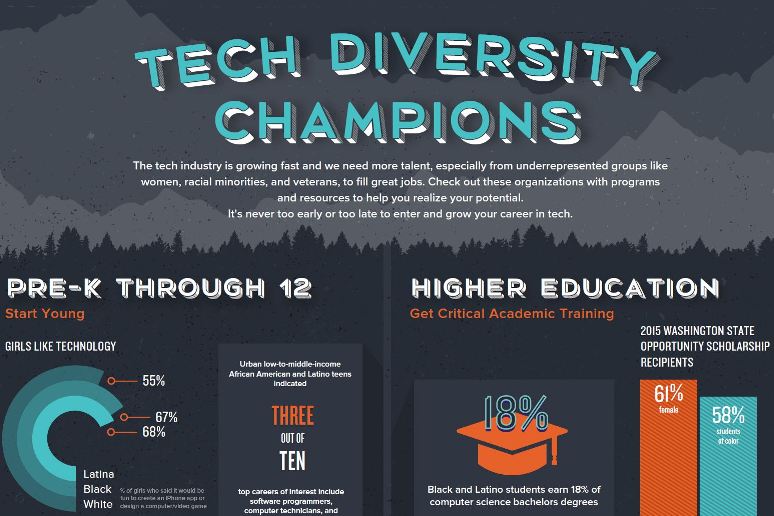
21 Jul 55 Washington Programs Helping Improve Diversity in Tech by Benjamin Romano
The technology industry’s diversity deficit is no secret, and with the issue out in the open, attention is turning toward potential solutions. To that end, the Washington Technology Industry Association produced a comprehensive listing of 55 programs in the state already working to help women, under-represented minorities, and veterans into the tech industry at every level.
The trade association’s Tech Diversity Champions infographic is meant to be a resource for people looking to prepare for a career in the lucrative industry, and for executives and recruiters clamoring for talent to fill job openings, and, increasingly, to diversify their organizations’ ranks.
The WTIA ramped up its efforts on this front two years ago after hosting a discussion with Seattle-area technology leaders and the Rev. Jesse Jackson. WTIA CEO Michael Schutzler says the organization began by trying to understand what’s causing such low participation rates in the industry among African Americans and other under-represented minorities.
Last fall, WTIA devoted its technology conference to addressing the industry’s lack of diversity. One idea that emerged from the conference was to catalog and evaluate the many organizations around the state that are helping expand access to the tech industry.
“There are many wonderful organizations who are making substantial inroads on solving this dilemma of providing access to people of color and women into careers in the tech industry,” Schutzler says.
But until now, no one had taken a close look at these organizations, and listed them all in one place, he says.
“The exercise took quite a bit of time because we needed to vet fact from fiction,” Schutzler says.
A WTIA committee made the list with help from reviewers at HERE Seattle (which helped design the infographic), Technology Access Foundation, Washington MESA, and others. They used the following criteria: Programs must currently provide direct help to women, minorities, or veterans who are seeking to join the tech industry. Organizations involved in advocacy only, or those that provide general education or professional development resources were not included. Private companies and code schools that have diversity scholarships, or provide unique resources, were also included.
WTIA highlights programs in four areas, and adds statistics that Schutzler says were selected to help dispel some common misperceptions.
For example, the section on programs for students in pre-school through high school notes that 68 percent of Latina girls said creating an iPhone app or video game would be fun, citing a Girl Scouts survey.
That contrasts with an “absurd” belief in some tech circles that girls, and Latinas in particular, don’t want to be in the field and self-select out at an early age, Schutzler says.
“There’s great interest. The question is, How do I get in? We have an access problem,” he says.
The WTIA lists 20 programs ranging from Code.org, which advocates for computer science education nationwide, to the Technology Access Foundation, which this year marks two decades of empowering children of color through STEM education. These groups “do an excellent job of providing access and opportunity for kids at this age to explore careers and to also pursue the fundamentals necessary to have the opportunity for a career in the tech industry,” Schutzler says.
Similar resources are offered in the categories of higher education, career transitions, and tech professionals.
Schutzler says inventorying the work already going on gives him “an enormous amount of hope and confidence,” but he’s not expecting change to happen overnight, or even over the course of a few years. There’s a long way to go. Women represent less than 20 percent of the engineering workforce at most major tech companies; African Americans and Latinos, combined, typically make up less than 5 percent.
“These programs will all start to move that needle dramatically over the next 10 years,” he says.
The next big focus must be retention, he says, noting that women leave the tech industry at a much higher rate than men.
“If you’re the only woman in a room of 10 guys, even if you’re being welcomed with open arms you still feel like the odd person out,” he says. “When you talk to the one or two black people who are engineers [at a given Seattle tech company], one of their biggest complaints is there’s no other black engineers. How do I connect to somebody else?”
One solution, he says, is groups that create community for under-represented minorities across the industry. Examples include HERE Seattle, NWCIT Latinas & IT, Women in Tech, and other organizations that help “navigate through this—at the moment—still largely white, male industry.”
Benjamin Romano is editor of Xconomy Seattle. Email him at bromano [at] xconomy.com. Follow @bromano


Sorry, the comment form is closed at this time.